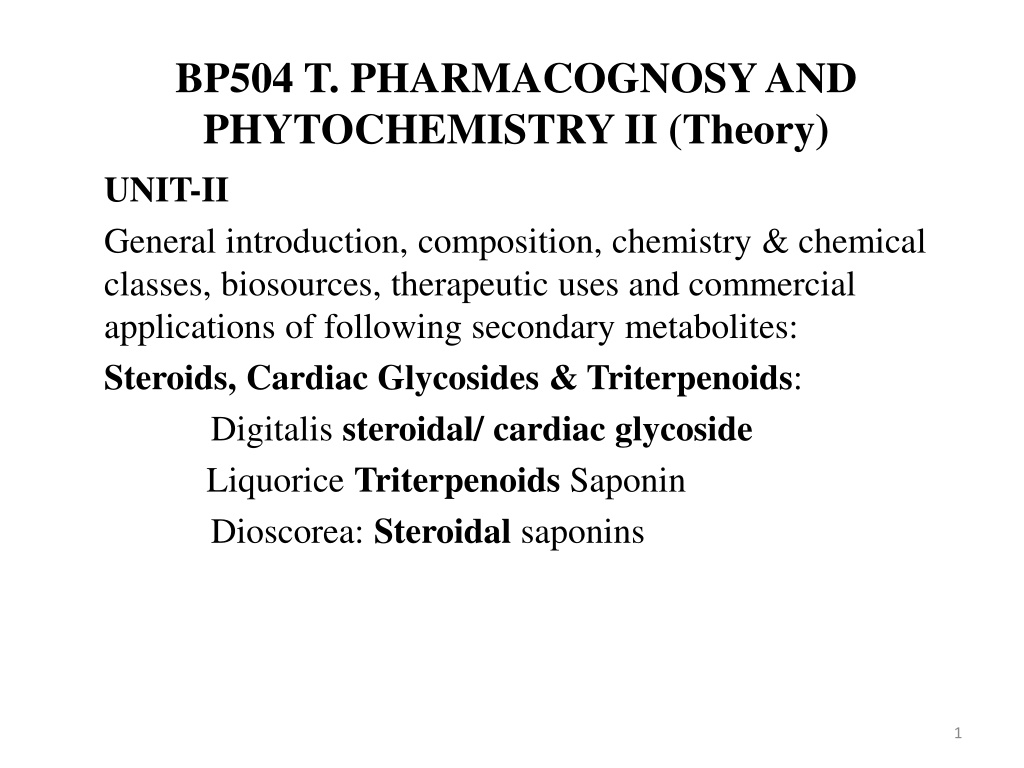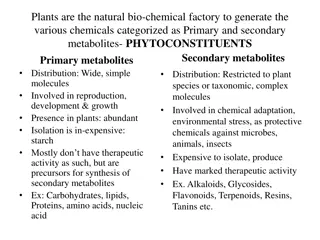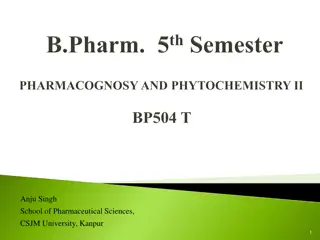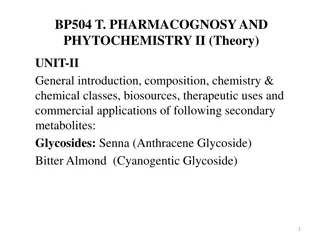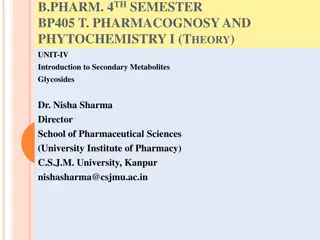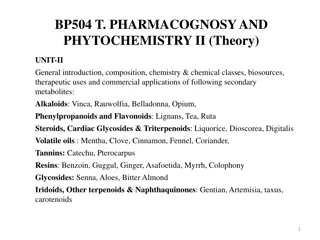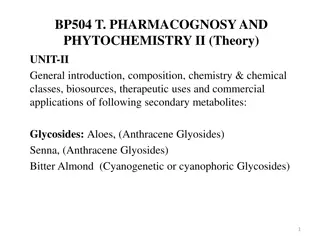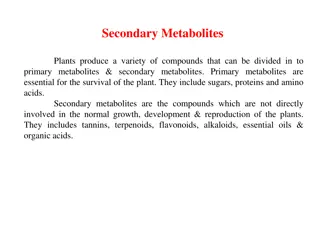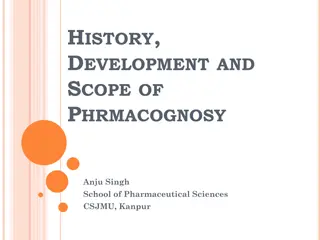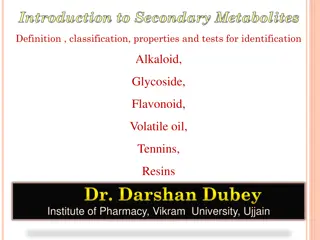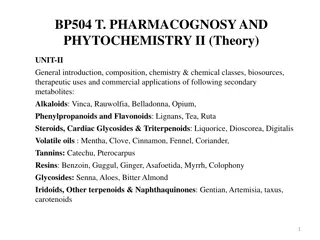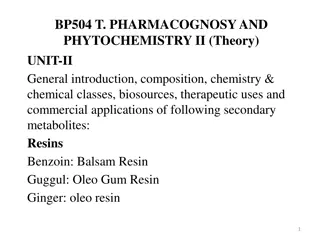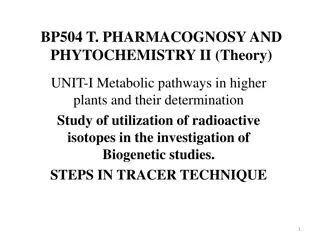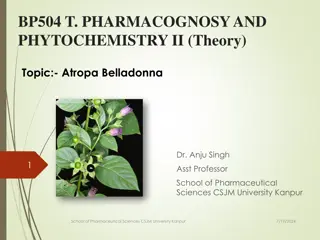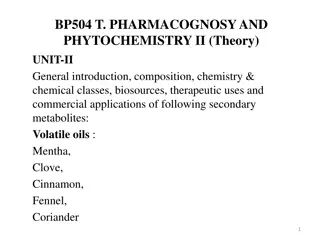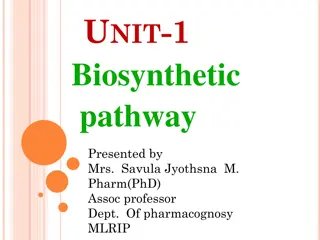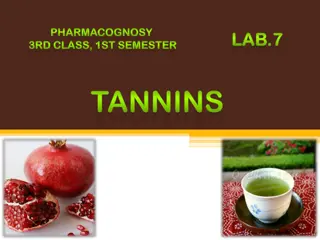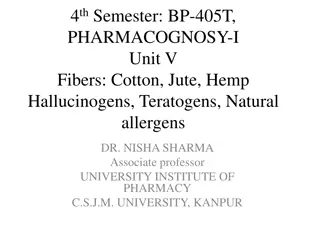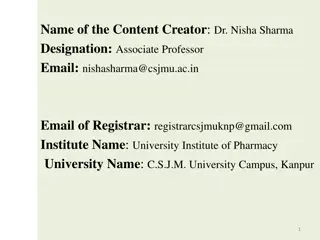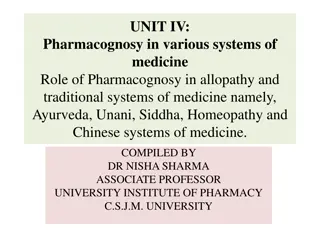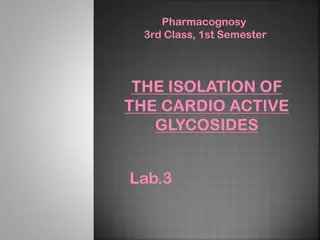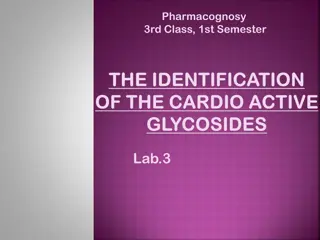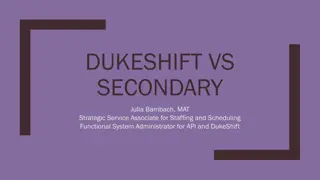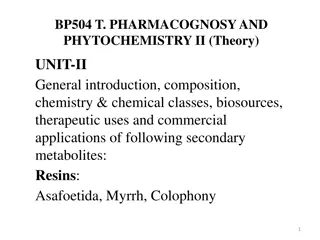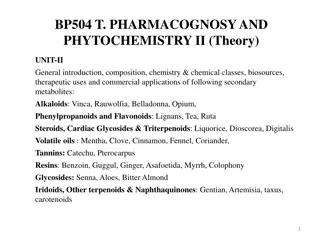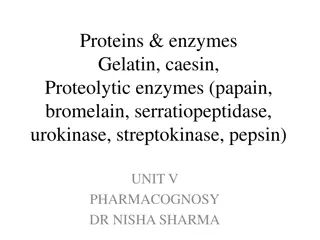Pharmacognosy and Phytochemistry II: Secondary Metabolites and Their Therapeutic Applications
This unit delves into the composition, chemistry, therapeutic uses, and commercial applications of secondary metabolites such as steroids, cardiac glycosides, and triterpenoids. It explores the properties of saponin glycosides, their classification based on aglycone nature, and the significance of steroidal saponins and pentacyclic triterpenoid saponins in medicinal synthesis. The content highlights the distribution of steroidal saponins in plant sources and the role of triterpenoid acids in drug formation.
Download Presentation

Please find below an Image/Link to download the presentation.
The content on the website is provided AS IS for your information and personal use only. It may not be sold, licensed, or shared on other websites without obtaining consent from the author. Download presentation by click this link. If you encounter any issues during the download, it is possible that the publisher has removed the file from their server.
E N D
Presentation Transcript
BP504 T. PHARMACOGNOSY AND PHYTOCHEMISTRY II (Theory) UNIT-II General introduction, composition, chemistry & chemical classes, biosources, therapeutic uses and commercial applications of following secondary metabolites: Steroids, Cardiac Glycosides & Triterpenoids: Digitalis steroidal/ cardiac glycoside Liquorice Triterpenoids Saponin Dioscorea: Steroidal saponins 1
SAPONIN GLYCOSIDE aglycone part of these glycosides has soap like action. some physical properties like foaming action by shaking with water and yielding colloidal solutions. haemotoxic, because they cause haemolysis of erythrocytes. used as fish poisons. Saponins have a bitter and acrid taste. cause irritation of mucous membrane. Contain aglycone called as sapogenin. harmful sapogenins are called as sapotoxins. 2
SAPONIN GLYCOSIDE Depending on the nature of aglycone, saponins are categorized into 2 groups (i) Steroidal saponins (Tetracyclic triterpenoid saponins) (ii) Pentacyclic triterpenoid saponins Both types of aglycones are linked with different types of sugars and uronic acids. 3
Steroidal Saponins More important- used as raw material for the synthesis of various medicinally useful steroids like vitamin D, cardiac glycosides, corticoids like betamethasone and cortisone acetate, sex hormones like progesterone, testosterone and oestradiol, oral contraceptives such as mestranol and norethisterone; and spironolactone which is a diuretic steroid. Steroidal sapogenins ex. diosgenin and hecogenin- considered representative example of this group of saponins. Distribution -limited to plant kingdom. In dicot plants, important sources are : Leguminosae, Solanaceae, Apocynaceae, etc. From monocot plants like Liliaceae, Dioscoreaceae and Amaryllidaceae. 4
Pentacyclic Triterpenoid Saponins Pentacyclic Triterpenoid Saponins This group contains the sapogenin with pentacyclic triterpenoid nucleus, which is linked with sugars or uronic acids. The sapogenin is further differentiated into (a) - amyrin type; (b) - amyrin type; and (c) Lupeol. 5
Triterpenoid acids An important derivative of this group is triterpenoid acids. These acids are present in various drugs formed by substitution of carboxylic group at C4, C17 and C20. 6
Pentacyclic triterpenoid Saponins They differ from steroidal saponins in their chemical structure and by way of their distribution. Reported in various families of dicot plants like Polygalaceae, Caryophyllaceae, Berberidaceae, Umbelliferae, Rubiaceae, Compositae, Primulaceae, Rutaceae, Chenopodiaceae, etc. They are however scarcely found in monocot plants. 7
Dioscorea Synonyms: Yam, Rheumatism root. Biological Source: consists of dried tubers of the plants, Dioscorea deltoidea, D. composita, and other species of Dioscorea, family Dioscoreaceae. D. deltoidea found in North Western Himalayas Kashmir & Punjab to Nepal & China upto an altitude of 1000 to 3000 m. Cultivated in Jammu and Kashmir and in part of Himachal Pradesh. D. deltoidea also found in U.S.A. and Mexico. Fresh tuber-yield as high as, 18 tones per hectare, can be expected from two year crop. Harvesting - by deep ploughing in the dormant season, during this the diosgenin content is high. Rhizomes lose about 50 per cent of their weight on drying. 8
Dioscorea Morphology: Colour - Slightly brown Odour - Odourless Taste - Bitter Size - Varies depending upon age of rhizomes It is a climber with alternate leaves Rhizomes are soft, horizontally arranged and are very close to the soil. Drug is covered with scattered roots. They weigh about 20-50 g. Chemical Constituents : 75 per cent of starch. They are non-edible, as very bitter in taste. Chief active constituent of dioscorea is diosgenin, a steroidal sapogenin (4 to 6%), & its glycosides, smilagenin and epismilagenin and - isomer yammogenin. 9
Dioscorea Rhizomes are also found to contain an enzyme sapogenase. Tubers are also rich in glycosides, and phenolic compounds. Diosgenin is the hydrolytic product of saponin-dioscin. Uses: Pharmaceutically, the rhizomes are used as rich source of diosgenin. Diosgenin being steroidal in nature is used as precursor for synthesis of several corticosteroids, sex- hormones, and oral contraceptives. Dioscorea is used in the treatment of rheumatic arthritis. 10
Allied Species Dioscorea flouribunda : cultivated in Central America & India (Karnataka State). Contains 3 to 5% diosgenin. D. villosa from Virginia and Carolina in U.S.A. rich in diosgenin content. It is a twining perennial with yellow flowers and triangular capsules. Sikkimensis Prain and Burkill (syn. D. deltoidea wall var. sikkimensis Prain) occurs in Eastern Himalayas, Nepal, Sikkim, Bhutan, Assam, Bihar and Bengal upto an altitude of 1600 - 2000 m. Contains 2 to 2.8 % of diosgenin. Costus speciosus is an alternative potential source for diosgenin (1.5%) and can be used as a substitute for the genuine drug. 11
Liquorice Glycyrrhiza, Liquorice root, Glycyrrhizae radix, Mulethi, Yasti consists of dried, unpeeled, roots and stolons of Glycyrrhiza glabra Linn, belonging to family Leguminosae. Yasti contains not less than 3.0 per cent of glycyrrhinic acid. is commercially cultivated on a large scale in Spain, Sicily and England. Glycyrrhiza glabra var. glandulifera (Russian liquorice) grows in Russia and Glycyrrhiza glabra var. violacea comes from Iran. 12
Different varieties of G. glabra 1. G. glabra var. typica: (Spanish liquorice): This plant has purplish blue coloured papilionaceous flowers. It gives out large number of stolons. 2. G. glabra var. glandulifera (Russian liquorice): It has a big root stock along with a number of elongated roots, but does not bear stolons. 3. G. glabra var. violacea (Persian liquorice): This plant shows violet flowers. Spanish liquorice is cultivated on a large scale in Spain and Italy. Propagation is done with young pieces of stolons. divided into young pieces, each piece must be with 2 - 3 buds of aerial shoot. 13
Liquorice Mophology : Color - Unpeeled-yellowish-brown or dark brown externally, & yellowish internally, Peeled liquorice pale yellow in color. Odor - Faint and characteristic. Taste - Sweet. Size - Length 20 to 50 cm and 2 cm in diameter. Shape - Cylindrical pieces that are straight may be peeled or unpeeled. Peeled liquorice is angular. Fracture - It is fibrous in the bark and splintery in wood. 14
Liquorice Unpeeled pieces show presence of small buds encircling scaly leaves and longitudinally the drug is wrinkled, while the peeled drug is fibrous without wrinkles. Chemical Constituents: Chief constituent of liquorice is a triterpenoid saponin known as glycyrrhizin (glycyrrhizic acid), it is K and Ca salt of glycyrrhizinic acid. Glycyrrhizinic acid is a glycoside & on hydrolysis yields glycyrrhetinic acid (glycyrrhetic acid), which has a triterpenoid structure. The different varieties are found to contain varying amounts of glycyrrhizin (from 6 to 14). 15
Liquorice Spanish liquorice contains 5 to 10%, Russian variety contains about 10 %, while Persian liquorice contains 7.5 to 13 % of glycyrrhizin. Other constituents of Liquorice are glucose (upto 4%); sucrose (2.5 to 6.5%); bitter principle glycyramarin resins, asparagin (2 to 4%) and fat. Important chemical aspect of liquorice is the presence of flavonoids which cause antigastric effect and are useful in peptic ulcer treatment. The flavonoids, yellow in colour, are liquiritin and isoliquiritin. The Indian liquorice roots : presence of 2 - methylisoflavones and a coumarin viz. Iiquo-coumarin. 16
Liquorice Carbenoxolone : an oleandane derivative prepared from glycyrrhiza & possesses significant minerocorticoid activity. used as an anti-ulcer drug. It changes the composition of mucous and increases mucosal barrier for the diffusion of acid. It is postulated that carbenoxolone inhibits the enzymes which inactivate prostaglandins and suppresses the activation of pepsinogen. This drug has marked anti-inflammatory effects. It is employed in treatment of gastric and duodenal ulcers. It is also used along with antacids for treatment of gastric reflux and reflux oesophagitis. It has also application in the form of gel for mouthwash in treatment of oral ulcers. 17
Chemical Test On addition of 80 per cent sulphuric acid, the thick section of drug or powder shows deep yellow colour. Uses : It has been used as an expectorant and demulcent. Used in cough mixtures, & as a flavouring agent in formulations with nauseous drugs like, ammonium chloride, alkali iodides, quinine, cascara, etc. Due to flavonoids content (isoliquiritin) with antigastric effects, it is used in peptic ulcer in the form of deglycyrrhized liquorice (DGL). This form has a reduced minerocorticoid activity and therefore used in treatment of peptic ulcer, for healing purposes. 19
Uses The drug is also an antispasmodic. This is due to flavonoids glycoside viz. isoliquiritin, the aglycone part of this glycoside has antispasmodic effects. Because of minerocorticoid activity (due to glycyrrhetinic acid), it is employed in place of corticosteroids for the treatment of rheumatoid arthritis, inflammations and Addision's disease. But, the heavy doses may cause sodium retention, consequently leading to hypertension, water retention and severe electrolyte imbalance. Glycyrrhizin is an established anti-inflammatory drug. 20
Uses Liquorice is used most commonly as a flavouring agent for chewing tobacco and snuff tobacco. Ammoniated glycyrrhiza is used as a flavouring agent in beverages, confectionery and pharmaceuticals. Residual matter remaining in the preparation of liquorice liquid extract is reported to have been used as a foam stabilizer in foam type of fire extinguisher. Liquorice is an ingredient of liquorice compound powder which is claimed to have a potentiating action of senna. 21
Other Preparations 1. Liquorice powder: It is a powder of peeled drug. 2. Liquorice compound powder: It contains senna leaf, liquorice, fennel, sublimed sulphur and sucrose and is used as laxative. 3. Liquorice liquid extract 4. Glycyrrhiza fluid extract: It contains liquorice, ammonia and alcohol. 5. Liquorice lozenges: It contains liquorice extract and anise oil along with a base. 6. Ammoniated glycyrrhizin: It is the ammonium salt of glycyrrhizin and used as sweetening agent. 7. Stick liquorice 22
Adulterants and Substitutes Manchurian liquorice obtained from Glycyrrhiza uralensis. It is pale chocolate brown in colour with exfoliated cork and wavy medullary rays. It is free from sugar, but contains glycyrrhizin. Russian liquorice may be peeled and obtained from Glycyrrhiza glabra variety glandulifera. The drug is purplish in colour with numerous long roots, but no stolons. 23
